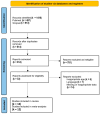Autonomic Function in Obese Children and Adolescents: Systematic Review and Meta-Analysis
- PMID: 38610619
- PMCID: PMC11012290
- DOI: 10.3390/jcm13071854
Autonomic Function in Obese Children and Adolescents: Systematic Review and Meta-Analysis
Abstract
Background: Obesity is invariably accompanied by autonomic dysfunction, although data in pediatric populations are conflicting. Methods: We conducted a systematic review and meta-analysis of 12 studies (totaling 1102 participants) comparing obese and normal-weight subjects (5-18 years of age), defined as body mass index >95th or <85th percentile, respectively. Using a random-effects model, we report the standardized mean differences (SMD) of sympathetic and vagal indices of heart rate variability. Results: Autonomic dysfunction was present in the obesity group, based on the average SMD in the standard deviation of sinus intervals (at -0.5340), and on the ratio of low (LF)- to high (HF)-frequency spectra (at 0.5735). There was no difference in sympathetic activity, but the heterogeneity among the relevant studies weakens this result. SMD in HF (at 0.5876), in the root mean square of successive differences between intervals (at -0.6333), and in the number of times successive intervals exceeded 50 ms divided by the total number of intervals (at -0.5867) indicated lower vagal activity in the obesity group. Conclusions: Autonomic dysfunction is present in obese children and adolescents, attributed to lower vagal activity. Further studies are needed in various pediatric cohorts, placing emphasis on sympathetic activity.
Keywords: adolescents; autonomic nervous system; children; heart rate variability; obesity; sympathetic activity; vagal activity.
Conflict of interest statement
The authors declare no conflicts of interest.
Figures








References
Publication types
LinkOut - more resources
Full Text Sources
Research Materials
Miscellaneous

